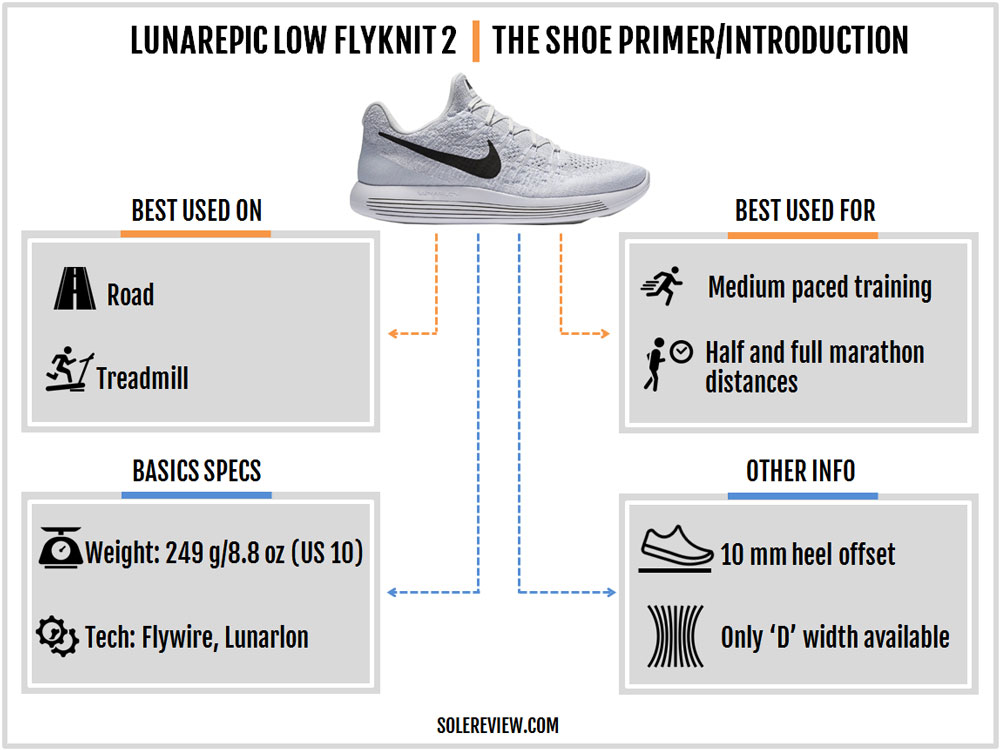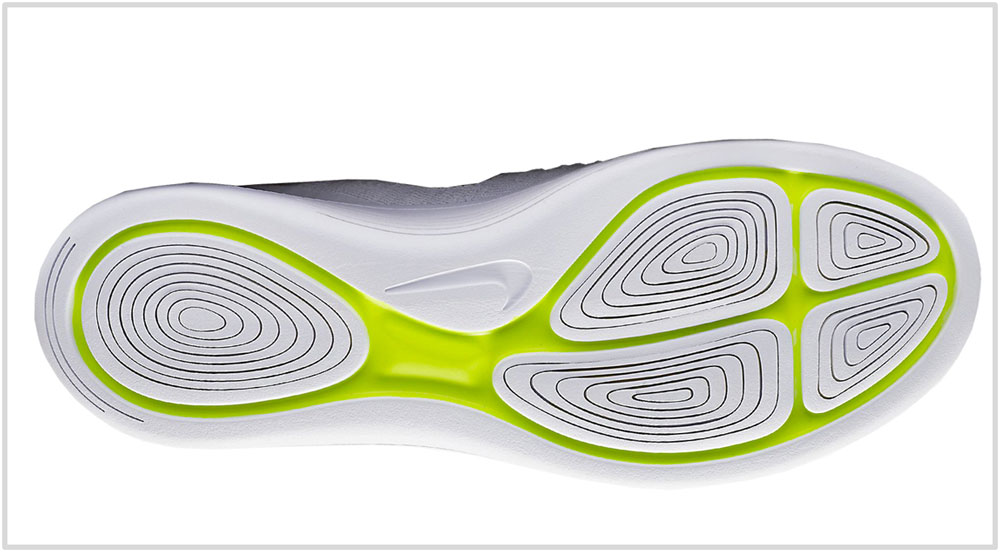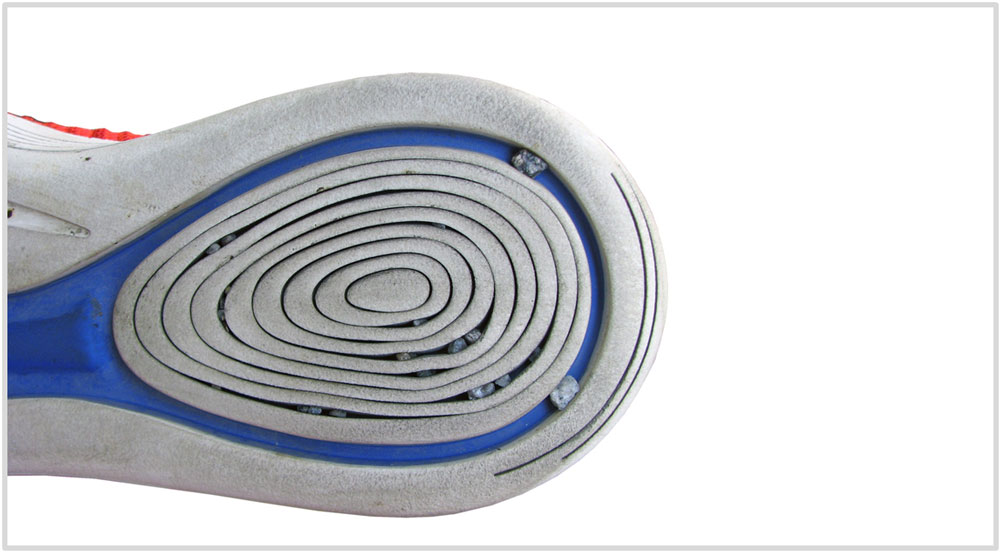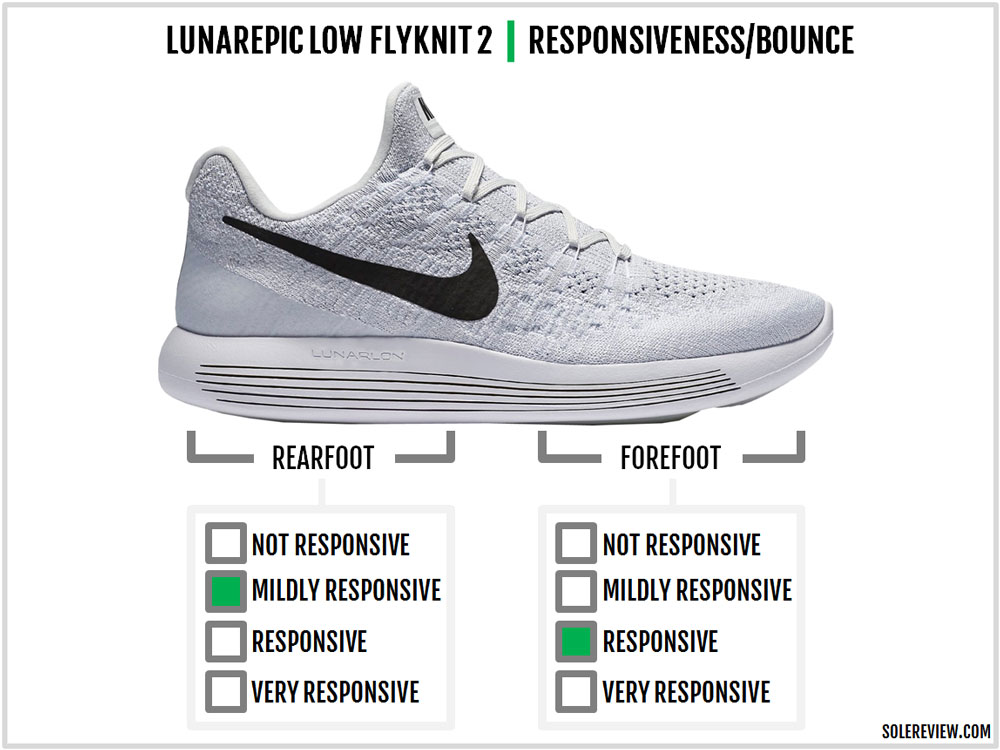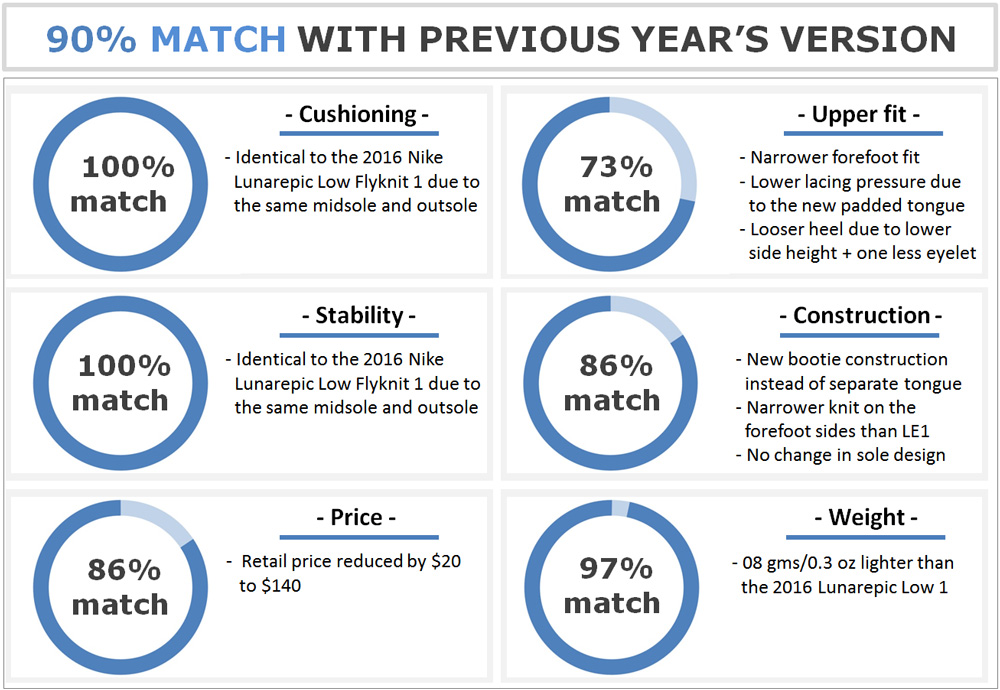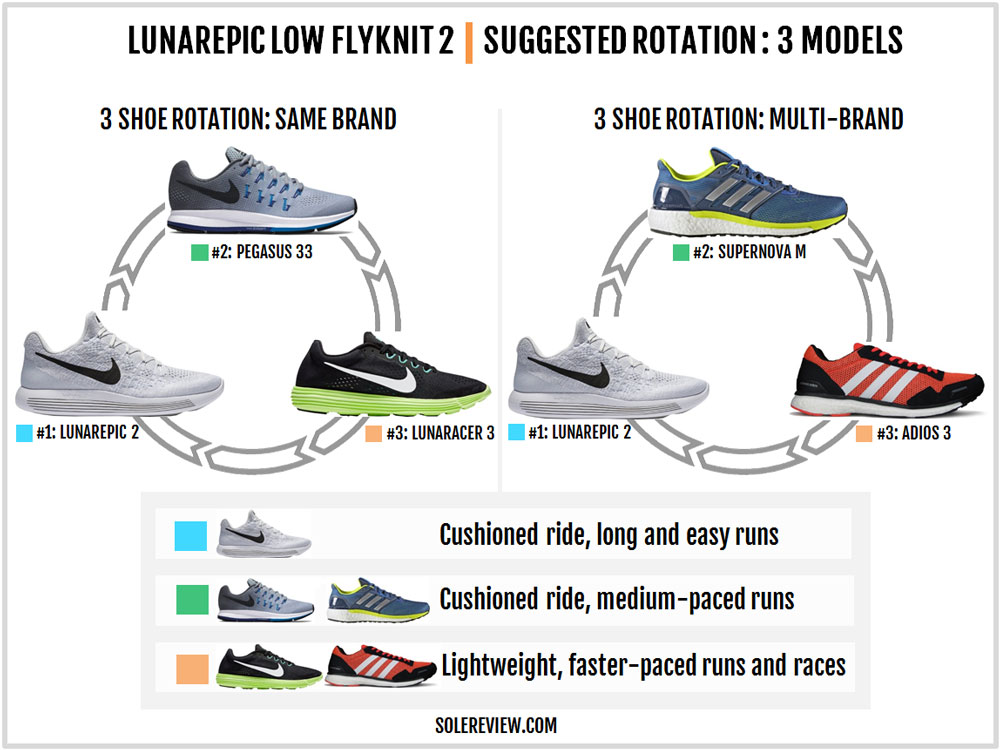INTRODUCTION
The first edition of the Lunarepic Flyknit was the high-ankle model. ‘A flawed genius,’ is the term we used to describe it back then. While there were plenty of good things to say about the shoe, the thick seam inside the elastic ankle band produced blisters.
Thankfully, the low version of the Lunarepic soon followed. Using the same midsole as the Hi model, the upper was built using a conventional heel and a separate tongue.
With the inner seam gone, the low version became a comfortable shoe to run in. The Lunarlon fused midsole with its laser-cut sidewall grooves delivered supportive cushioning, and the consistent use of Lunarlon + EVA stacking from heel to toe made the transitions smooth.
The last year’s Lunarepic Flyknit Low (V1) was an unofficial replacement for the Flyknit Lunar 3. The Lunarepic adopted the same core design aspects of the Flyknit Lunar 3, like the combination of a minimal Flyknit upper with a Lunarlon embedded midsole.
The first Lunarepic Low’s $160 pricing was a close match with the Lunar 3’s $150 price, and so was the higher heel-to-toe drop of 10 mm. And yes, both weigh nearly the same too. The current model of the Lunarepic Flyknit Low weighs 249 grams/8.8 Oz, which is pretty close to the Lunar 3’s weight.
So the Lunarepic does the same thing which the Flyknit Lunar 3 did. It is a generously cushioned trainer meant for daily training and races of greater mileages.
There is some confusion about the Lunarepic Low Flyknit 2’s retail price. A few retailers sell it at $160, while Nike’s website lists the LE2 at $140. Since Nike’s website is the last word on the official pricing, the LE2’s pricing (elsewhere) should correct itself to $140.
A $140 price means that the Low Lunarepic 2 is $20 cheaper than the last year’s edition.
As a product, not a lot has changed since the Lunarepic 1. The 2017 Lunarepic Low Flyknit 2 features a brand new upper design with a closed bootie construction – meaning that the tongue and heel are now integrated. Below, the midsole unit is carried over without any updates.
DESIGN AND MATERIALS
Both the Lunarepic Low 1 and 2 share a knit upper, but not without their design differences. The LE2’s forefoot has more stretch in it, and the knit structure is denser than the 2016 model. As a result, the LE2’s forefoot fits narrower than the outgoing model.
The lacing relies on Flywire cords embedded inside the knit upper. Flat laces pass through the thin loops created by Flywire snaking their way up the midfoot; this is also the right time to point out that the Lunarepic 2 has a one less eyelet row than the LE1.
The reason for the reduced eyelet count is the LE2’s new bootie sleeve design. The Lunarepic 1’s tongue was modeled on the Flyknit Lunar 3; the tongue was an unpadded and flat piece of textile which was not connected via a sleeve.
That changes on the Lunarepic Low 2. The tongue and heel are now joined in a sock-like opening, and this eliminates the last heel-lock eyelet seen on the LE1. Also, there’s another change in the heel design.
If you compare the side profiles of the LE1 and LE2, you’ll see that the collar height is significantly lower (7-10 mm) on the 2017 Lunarepic. This is over the sides of your ankle, where the LE2’s heel swoops down lower than the LE1.
This is one of the reasons why the heel fit of the LE2 doesn’t feel as secure as the LE1. The second reason is the tongue lip extends upwards rather towards the ankle, a design aspect which eases off lacing pressure over the foot. Do note that you will not be able to further dial up the heel fit because of the now-missing heel-lock eyelet.
Otherwise, the heel fit is comfortable. The fabric used is soft, there are no seams, and there’s plenty of padding to go around. We couldn’t help but notice that the Lunarepic Low Flyknit 2’s heel design bears a striking resemblance to the adidas Ultra Boost’s construction. Or even the Alphabounce.
There’s no hard counter inside the heel, which was the case on the LE1 too. That said, the 2017 LE2 uses a fused laminate over the outer heel which gives that area a little more structure than the LE1.
The thin strip running up on the heel center has a reflective strip as it was on the LE1. That’s all the reflectivity you get on the Lunarepic; the side Swoosh logos are fused but not reflective.
Another thing about the Lunarepic’s knit upper is that it isn’t as breathable as it looks. It runs warmer than shoes with an engineered mesh upper, so that’s something to keep in mind.
The midsole you get on the Lunarepic Low 2 made its debut on the high-ankle version of the Lunarepic. The midsole and outsole design made the headlines for various reasons, one of which was the laser-cut grooving over the midsole sides.
These grooves extend longer on the outer midsole sidewalls, making that side easier to compress than the inner midsole which has a shorter set of grooves. Inside the midsole, there’s a softer Lunarlon foam core, and you can get a glimpse of it if you pry the grooves open.
There’s no rubber used on the outsole. Instead, the Lunarepic uses raised foam pods with concentric grooves cut into them. This design makes the outsole grip excellent on dry surfaces, but there a couple of downsides.
The deep grooves are a pebble magnet, trapping all kinds of small debris during a run. The second is that foam parts will experience faster wear and tear than their rubber counterparts. Also, the grip isn’t great on wet or smooth surfaces.
Above the midsole is a dual stack of an Ortholite insole and foam lasting, both of which provide instant cushioning even during low-impact activities such as walking.
The Flyknit upper won’t be a concern with regards to durability. The knit upper is thick and elastic, and the overall materials are tried-and-tested over previous generations of the Lunarepic and other Flyknit shoes.
As with all Lunarlon based shoes, the longevity of the foam isn’t great. Lunarlon tends to lose its cushioning properties faster than other proprietary foams, and that applies to the Lunarepic too. Lunarlon is great while it lasts, but expect it to flatten once you cross 300 miles.
There’s no rubber used on the outsole, so the grooved edges of the foam pods will undergo faster wear and tear than say, the rubber used on the Pegasus. That also affects the grip quality, so the wear levels of the pods need to be monitored.
UPPER FIT AND FEEL
The Lunarepic’s toe box is quite shallow. The mesh is elastic, so the upper adjusts to your foot shape. In doing so, it tends to pin your toes down so this might take a while getting used to if you’re coming from a regular sized toe-box.
Flywire is used on the midfoot sides, but they work together with the lacing in a non-intrusive way. They do not apply side pressure, and the new padded tongue filters the lacing cinch better than the LE1.
The insides fit smooth, as expected of a seamless knit construction. The tongue doesn’t slide as it did on the Lunarepic Low 1 because it is now integrated with the heel.
Some runners might find the heel grip to be lacking, and that’s because of the lower collar height. The Achilles point is high enough, but then it swoops down deep on both sides before meeting the tongue.
This update changes the quality of heel fit. While the 2016 Lunarepic 1’s collar did a better job of connecting the Achilles dip to the tongue, the Lunarepic 2’s lower collar tones down the side grip.
Also worth mentioning is that because of the LE2’s one less eyelet hole, you can’t deploy the heel-lock lacing – an option which was available on the LE1.
The forefoot has a narrow fit. Sure, the elastic upper tends to wrap tight around the foot, but it’s not just that. The knit structure on the forefoot sides is denser than the Lunarepic 1, so on a relative level, the LE2 is narrower.
There are no optional widths, so should you choose to buy the Lunarepic 2, you’ll have to get used to the tight fit. Some may require a half size larger, but then you’ll end up with excess space in the front of your toes.
RIDE QUALITY AND BEHAVIOR
Most of the cushioning softness is confined to the upper reaches of the midsole. Which makes perfect sense, because that’s where most of the softer foam is.
The insole, foam lasting, and the Lunarlon insert combine to provide cushioning softness, while the lower part of the midsole is firmer. There is some level of cushioning from the EVA foam casing and the outsole pods, but it is a firmer kind. Most of the EVA midsole’s compression comes from the laser-cut groove which compresses under body weight.
The ride isn’t mushy; the firmer outer casing and softer Lunarlon work well together to deliver a well-balanced cushioning experience. The midsole stack is quite thick, so the Lunarepic 2 performs well as a long-mileage shoe including marathons – provided that the snug-fitting upper works for you.
Though the Lunarlon foam is mildly responsive by itself, the pod-like outsole contributes to the level of responsiveness. And surprisingly, the forefoot feels more responsive than the rear, and that’s due to the colony of four pods grouped together.
The raised pods under the forefoot provide more bounce than the rear, which only has a single pod shaped in a flat profile. This makes the Lunarepic a great shoe for forefoot strikers as well as heel strikers – forefoot strikers get more responsiveness, while rearfoot landing runners receive a higher dose of foam cushioning.
The high version of the Lunarepic Flyknit had an excellent transition quality, and that does not change on the LE 2 Low. The Lunarlon topped midsole delivers a smooth progression from heel to toe, and the laser-cut grooves add to the seamless ride character as well.
As far as the support levels are concerned, the Lunarepic fares reasonably well. The firmer EVA midsole creates a supportive base around the softer Lunarlon foam, though there is a bit of an outwards compression bias.
The outer midsole has longer laser-cut grooves which run nearly the entire length of the midsole, so that side tends to compress more easily. In contrast, the inner midsole has a shorter set of laser-cut side grooves. Hence, the arch side of the midsole comes across as more stable.
PROS AND CONS
Among the things we like on the Lunarepic Low Flyknit 2, the smooth ride quality comes out tops. The stack of the dual-density midsole tapers gently from heel to toe, so the transition is smooth and progressive. The lightweight build of the Lunarepic (8.8 oz/249 grams) is also instrumental in shaping the effortless nature of the midsole’s ride.
The cushioning is an optimal blend of soft and firm, which ensures that the Lunarepic’s midsole stays free of any sink-spots. The ride is supportive due to the firmer midsole casing, and the forefoot is responsive owing to the multiple foam pods below. And on dry surfaces, the outsole grips extremely well.
While the upper interiors have a smooth fit quality, the narrow forefoot fit might not be liked by all. And it’s not as if you can remedy the fit situation, because the Lunarepic Flyknit Low 2 does not come in additional width sizes.
The changes made to the heel area – which involves lowering the sides – impacts the quality of fit. Though the heel doesn’t slip during runs, it feels like so.
And lastly, the grooved outsole is a veritable magnet for small rocks, dead bugs and other debris of a similar kind.
SUMMARY
The Lunarepic 2 cuts $20 off the Lunarepic 1’s retail price, so that’s a welcome change. This places the LE2’s price on par with the Vomero 12, and $10 less than the Flyknit Lunar 3. While at it, the shoe sheds some weight compared to the LE1 – 0.3 ounces or 8 grams to be precise.
The midsole and outsole have been left untouched, so all things ride related – be it the cushioning or the transition quality – stays the same. The upper, however, is another story.
The forefoot turns narrower due to the change in the knit mesh structure, and the heel collar evolves into a bootie type. In the process, the heel also gets additional reinforcement in the form of an external laminated layer.
On the flip side, the LE2’s upper heel grip feels less secure than the LE1 due to the lower side heights and the change in the tongue design.
RECOMMENDED ROTATION
There aren’t many Lunarlon based shoes in Nike’s lineup these days, so your rotational choices will be limited if confined to only Lunarlon running shoes.
The Pegasus 33 is a good add into the mix; it is capable of handling more abuse than the Lunarepic, and the Zoom Air bags make the ride more responsive. The upper is more comfortable too.
The Pegasus can serve as a dual purpose shoe, good for both medium and easy running paces. For race days or just speed training, the Lunaracer 4 pairs up perfectly with the Lunarepic. The Lunaracer is incredibly lightweight, and will make short work of track workouts and even long races – there’s enough cushioning to go.
If the Lunarepic Low 2 is the only Nike shoe you wish to stick to, consider the adidas Supernova M as your second cushioned trainer, and the adios 3 Boost as your race-day/fast shoe.
SIMILAR NEUTRAL CUSHIONED SHOES
The Lunarepic Low 2 is a premium neutral cushioned trainer with a high heel-to-toe offset, so there’s plenty of other shoes to choose from.
Most of the other models on this chart are based on a more conventional design. Unlike the Lunarepic’s all-foam midsole and outsole, shoes listed here use a combination of foam and rubber to craft their bottom parts.
The Asics Nimbus 19 is the Japanese brand’s flagship neutral cushioned shoe. Though the shoe has evolved by much over the last few editions, it is a well-cushioned shoe and works well for daily runs. See our detailed reviews list for most of the shoes mentioned in this section, and more.
If a bouncy and cushioned ride is what you want, then the adidas Glide 9 (aka the Supernova M) is the shoe to get. A full-length Boost midsole ensures a responsive ride, and the Continental rubber outsole is very durable.
The Brooks Glycerin 14 isn’t groundbreaking in any way. It just happens to be a smooth riding cushioned trainer with premium materials used all around. The New Balance 1080 V7 offers a fuss-free ride thanks to its single-density midsole, and the Nike Vomero 12 provides increased cushioning and responsiveness over the Lunarepic Low.
The Saucony Triumph ISO 3 has a rearfoot-biased cushioning due to the chunky Everun foam insert, while the rest of the midsole has a firm feel to it.


